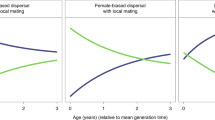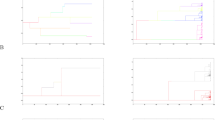Summary
Information from pedigrees provides the most accurate means of estimating relatedness within and between social groups, but the method has the disadvantage of requiring longterm breeding records. If a regular system of mating occurs, then kinship parameters may be estimated from recurrence relations which decribe the change in coancestry and inbreeding from generation to generation. Breeding records collected over a single generation are therefore sufficient. In this paper the island model is used for the derivation of general expression of the coancestry and inbreeding coefficients in a dioecious population with non-overlapping generations. An equation for the average coefficient of coancestry (f JJ) within a juvenile cohort is first found, and the other coefficients are then easily obtained. Parameters required are the inbreeding effective numbers of male and female parents and the migration rates of the two sexes. — In species with overlapping generations, the average coefficient of coancestry of the juvenile cohort is not related simply by migration rates to the average coancestries of the adult classes. The difference arises because average coancestry between pairs of individuals chosen from different cohorts is not in general the same as that between pairs of the same cohort. The precise difference depends on the mating system and cohort structure of the social group. Suitable modification to the basic expression for f JJ is described. The use of the composite method is illustrated by reference to the social units of two large mammals: prides of lion and clans of impala.
Similar content being viewed by others
References
Altmann J (1979) Age cohorts as paternal sibships. Behav Ecol Sociobiol 6:161–164
Bertram BCR (1976) Kin selection in lions and in evolution. In: Bateson PPG, Hinde RA (eds) Growing points in ethology. Cambridge University Press, Cambridge, pp 281–301
Bygott JD, Bertram BCR, Hanby JP (1979) Male lions in large coalitions gain reproductive advantage. Nature 282:839–841
Chagnon NA (1975) Genealogy, solidarity, and relatedness: Limits to local group size and patterns of fissioning in an expanding population. Yearb Phys Anthropol 19:95–110
Chepko-Sade BD, Olivier TJ (1979) Coefficient of genetic relationship and the probability of intragenealogical fission in Macaca mulatta. Behav Ecol Sociobiol 5:263–278
Craig R, Crozier RH (1979) Relatedness in the polygynous ant Myrmecia pilosula. Evolution 33:335–341
Crow JF, Kimura M (1970) An introduction to population genetics theory. Harper and Row, New York
Crozier RH (1980) Genetical structure of social insect populations. In: Markl H (ed) Evolution of social behavior: hypotheses and empirical tests. Dahlem Workshop Reports, pp 129–146
Crozier RH, Pamilo P, Crozier YC (1984) Relatedness and microgeographic genetic variation in Rhytidoponera mayri, an Australian arid-zone ant. Behav Ecol Sociobiol 15:143–150
Falconer DS (1981) Introduction to quantitative genetics, 2nd edn. Longman, London
Hamilton WD (1972) Altruism and related phenomena mainly in social insects. Annu Rev Ecol Syst 3:193–232
Hamilton WD (1975) Inate social aptitudes of man: an approach from evolutionary genetics. In: Fox R (ed) Bisocial anthropology. Malaby Press, London, pp 133–155
Kimura M, Ohta T (1971) Theoretical aspects of population genetics. Princeton University Press, Princeton
Kurland JA (1977) Kin selection in the Japanese monkey. Contrib Primatol 12. Karger, Basel
Latter DH, Sved JA (1981) Migration and mutation in stochastic models of gene frequency change. II. Stochastic migration with a finite number of islands. J Math Biol 13:95–104
Lester LJ, Selander RK (1981) Genetic relatedness and the social organization of Polistes. Am Nat 117:146–166
Malécot G (1969) The mathematics of heredity. Freeman, San Francisco
McCracken GF, Bradbury JW (1977) Paternity and genetic heterogeneity in the polygynous bat, Phyllostomus hastatus. Science 198:303–306
Metcalf RA, Whitt GS (1977) Intra-nest relatedness in the social wasp, Polistes metricus. Behav Ecol Sociobiol 2:339–351
Michod RE, Anderson WW (1979) Measures of genetic relationship and the concept of exclusive fitness. Am Nat 114:636–647
Michod RE, Hamilton WD (1980) Coefficients of relatedness in sociobiology. Nature 288:694–697
Murray MG (1981) Structure of association in impala (Aepyceros melampus). Behav Evol Sociobiol 9:23–33
Murray MG (1982) Home range, dispersal and the clan system of impala. Afr J Ecol 20:253–269
Packer C (1979) Inter-troop transfer and inbreeding avoidance in Papio anubis. Anim Behav 27:1–36
Pamilo P (1981) Genetic organization of Formica sanguinea populations. Behav Ecol Sociobiol 9:45–50
Pamilo P (1984) Genotypic correlation and regression in social groups: multiple alleles, multiple loci and subdivided populations. Genetics (in press)
Pamilo P, Crozier RH (1982) Measuring genetic relatedness in natural populations: methodology. Theor Popul Biol 21:171–193
Pamilo P, Varvio-Aho S (1979) Genetic structure of nests in the ant Formica sanguinea. Behav Ecol Sociobiol 6:91–98
Schwatz OA, Armitage KB (1983) Problems in the use of genetic similarity to show relatedness. Evolution 37:417–420
Seger J (1977) A numerical method for estimating coefficients of relationship in a langur troop. In: Hrdy SB, The langurs of Abu. Harvard University Press, Cambridge, Mass, pp 317–326
Ward PS (1983) Genetic relatedness and colony organization in a species complex of ponerine ants. I Phenotypic and genotypic composition of colonies. Behav Ecol Sociobiol 12:285–299
Wright S (1922) Coefficients of inbreeding and relationship. Am Nat 56:330–338
Wright S (1943) Isolation by distance. Genetics 28:114–138
Wright S (1951) The genetical structure of populations. Ann Eugen 15:323–354
Wright S (1969) Evolution and the genetics of populations, vol 2, The theory of gene frequencies. University of Chicago Press, Chicago
Wright S (1977) Evolution and the genetics of populations, vol 3, Experimental results and evolutionary deductions. University of Chicago Press, Chicago
Author information
Authors and Affiliations
Rights and permissions
About this article
Cite this article
Murray, M.G. Estimation of kinship parameters: the island model with separate sexes. Behav Ecol Sociobiol 16, 151–159 (1985). https://doi.org/10.1007/BF00295149
Received:
Accepted:
Issue Date:
DOI: https://doi.org/10.1007/BF00295149




